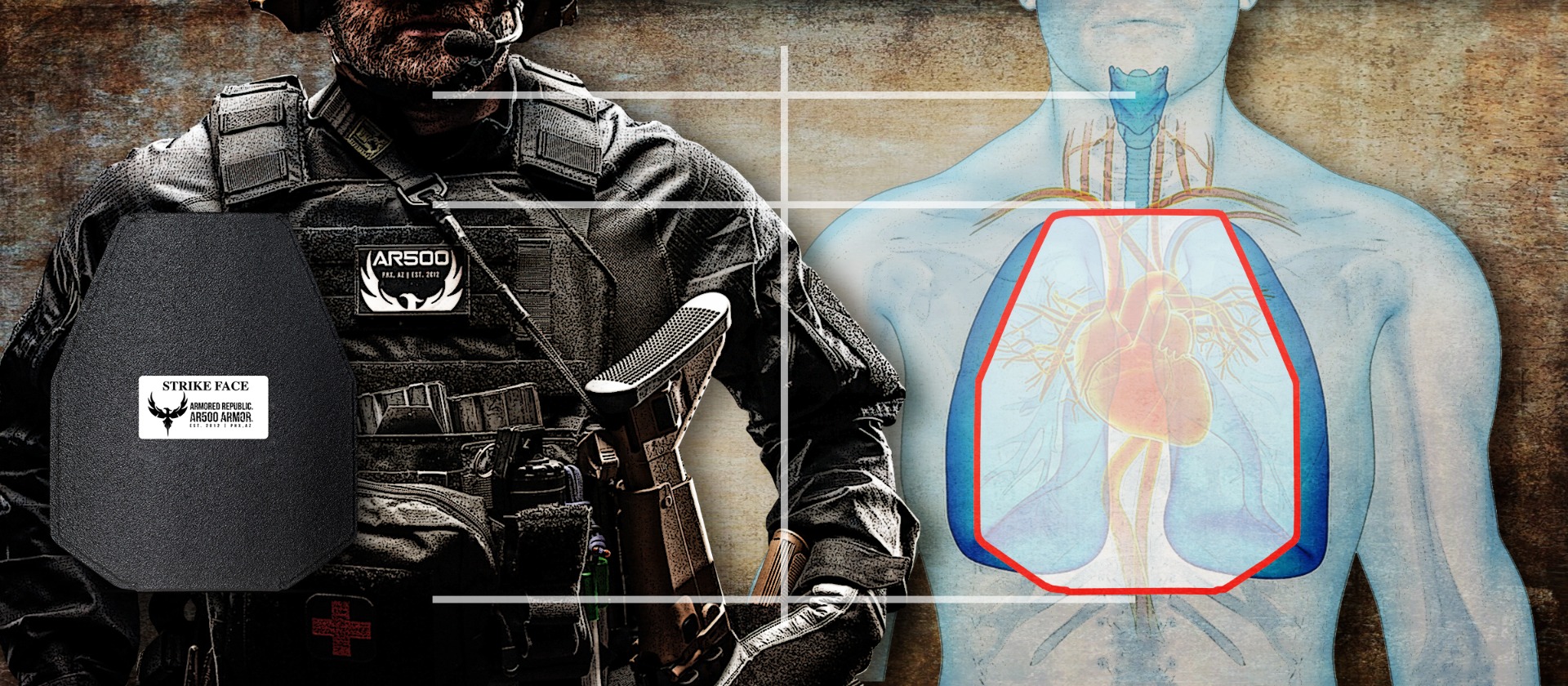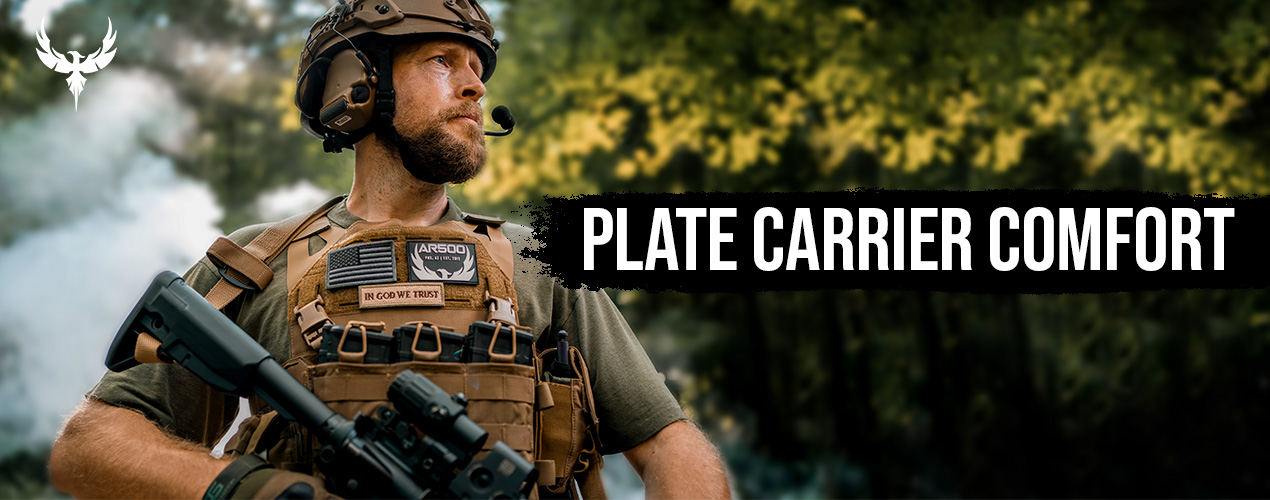If you have ever worn a plate carrier for an extended period of time, you may have come to find that it's not a pleasant experience. The weight of armor plates, lack of or worn-out shoulder padding, and improper plate carrier adjustment are some of the primary culprits that can lead to discomfort.
There are different ways to help with the long-term comfort of your carrier, which will help you get more usage out of it - keeping you safer for longer. Let’s dive in.
Make Sure Your Plate Carrier is Properly Adjusted
Having a properly adjusted plate carrier involves making sure you:
- Have the correct plate size for your torso
- The plates are correctly placed inside your plate carrier over the vital organ area of your chest: Plates should be suspended from the bottom of your clavicle line (collar bone) to about 2-3” above your navel (belly button). In addition, your plate should cover your torso laterally nipple to nipple.

To ensure your plates are suspended in your plate carrier properly, you will need to adjust the shoulder straps of your carrier. After your shoulder straps are adjusted, you will need to ensure your cummerbund or side buckle system is properly adjusted. This adjustment ensures there is no lateral plate sway.
Lastly, the plates should be worn firmly against your torso and back, but not too tight to where it would impede your breathing. If you were to jump, your plate carrier should not be bouncing up and down and shifting positions. Having the plate worn firmly against you ensures your plate is properly placed to prevent pendulum motions from causing stress along your vertebrae.
Do Your Shoulder Pads Need to be Replaced or Upgraded?
While you are confirming your shoulder strap adjustments, make sure to inspect your Shoulder Pads (if your carrier has them). Shoulder pads can be a “make or break” comfort feature. They bear the task of supporting the weight of your entire carrier and armor on top of your shoulders. If your carrier has no shoulder pads, your carrier's comfort level can be greatly increased by adding a set.
Does Your Carrier Have the Ability to Take Additional Padding?
Some plate carriers have the ability to add internal vertical padding strips between the main plate pocket and the wearer. These are called pontoon pads due to their resemblance to the helicopter landing gear of the same name.
Pontoon pads are small vertical pads that run the entire height of the plate pocket, usually two per plate pocket (four in total). These pads interrupt the contact point your plate pocket would normally make with your body, allowing for heat to escape through a large central channel. In addition to heat venting capabilities, pontoons suspend the weight of your carrier off of your spine.
You can assess if a carrier is intended to use pontoon pads by looking at the inside of the plate pocket and inspecting for two vertical strips of loop velcro running the height-length of the plate pocket.
Can You Lighten Your Armor Weight?
Simply put, the overall weight of a plate carrier is the underlying issue of discomfort and a majority of that weight is coming from your armor. All the adjustments and padding in the world won't help a carrier that is too heavy. The armor in your carrier makes up a significant portion of its weight. Assessing and changing your armor plate type can certainly make a difference in how comfortable your plate carrier is.
If you are using steel or ceramic armor and you want to reduce the weight of these armor types, you can look into different armor plate types. An excellent example would be polymer-type plates (made of UHMWPE) which provide level III protection like our P2 plate at only 3.3 pounds or a material blend (alloy and polyethylene) like our A3 plate which provides level III+ protection at only 4.6 pounds per plate. These are in stark comparison to the 8 to 9 pounds per plate of some steel and ceramic armor types offered.
Trauma Pads
Trauma Pads are non-newtonian pad that goes inside your plate carrier and are positioned between your armor and the inside of your plate pocket. These pads act as a buffer between you and the plate and are intended to help mitigate backface deformation forces that would otherwise be dispersed into your chest.
In addition to helping keep you in the fight by reducing these forces, trauma pads can help make your overall experience of wearing armor more comfortable. Some carriers on the market do not include any padding on the back of the plate pocket in an effort to keep the carrier as close to your body as possible (for profile thinness).
Although this can be a benefit to some, it can also make putting on your carrier and armor an unpleasant experience. Putting a trauma pad behind your armor can help make your carrier far more comfortable when donning and doffing, in addition, to long-term wear and ballistic backface reduction.
Strength Training
The last tip for comfort is one some may not want to hear: Strength resistance training. If you have assessed all the above and your plate carrier setup is still uncomfortable then it may simply be that you need to train more in it.
Doing physical activities in your armor helps your skeletal support muscles build up physical resistance to the increased weight of a vest. On top of doing normal carrier-type physical activities like hiking and running, strength training at a gym can help develop muscle groups like your trapezius (neck) and quadriceps (upper legs) that aid in reducing long-term plate carrier fatigue. Remember this is the only tip that you will not see an immediate benefit from and will require long-term, but well-rewarded commitment.
Conclusion
Being efficient on the battlefield means moving fast, unencumbered, and with purpose. Increasing your armor's comfort level will aid in your capabilities to do more in it.
